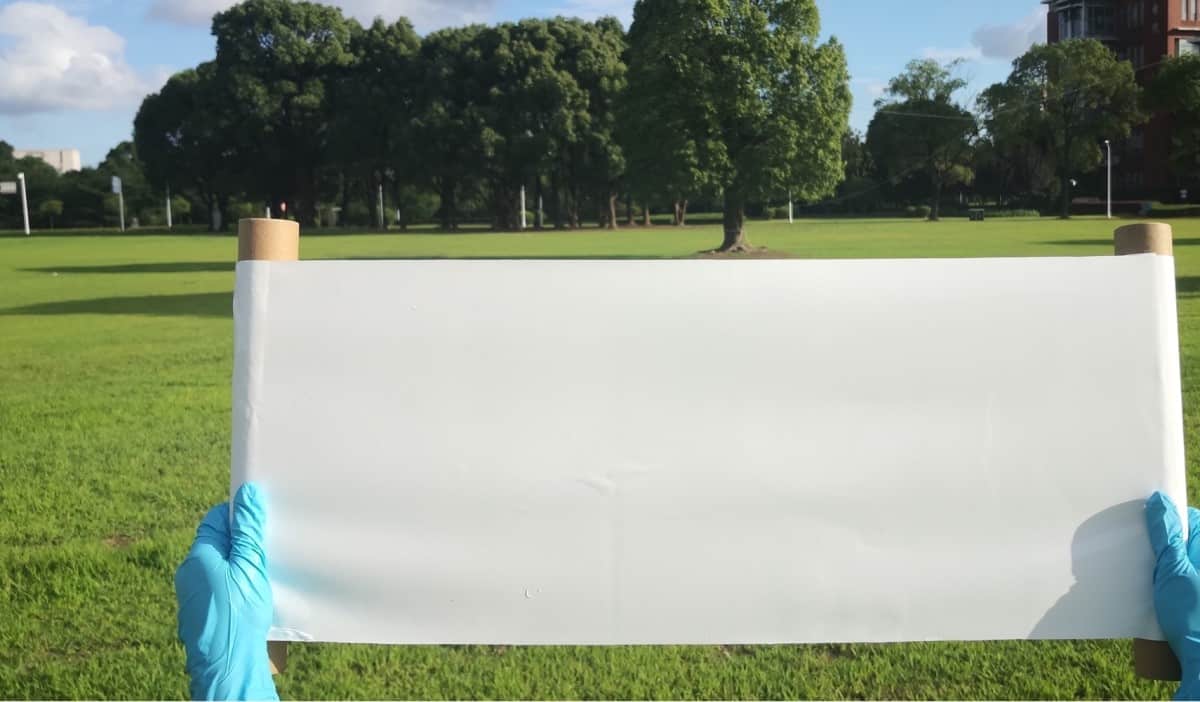
A new flexible material for passive cooling that was inspired by a volcano dwelling beetle has been developed by scientists in China, the US and Sweden. The film reflects around 95% of solar irradiance, and can reduce the surface temperature of objects by around 5 °C. It could be used to cool everything from buildings to electronics, the researchers say.
There are some 30,000 species of longhorn beetle, often characterized by having antennae that are much longer than the insect’s body. In southeast Asia one bright golden species, Neocerambyx gigas, is often found living on the slopes of active volcanoes, particularly on the Indonesian islands of Java and Sumatra. In these extreme environments summer temperatures often top 40 °C, while ground temperatures can exceed 70 °C. When it gets really hot, the beetles stop moving and foraging to help shed excess heat and reduce heat absorption.
Han Zhou, a materials scientist at the Shanghai Jiao Tong University in China, told Physics World that this ability to survive in extreme climates and the beetles “very brilliant appearance” attracted her team’s interest. Zhou and colleagues in Shanghai, the University of Texas at Austin and Sweden’s KTH Royal Institute of Technology wondered if the beetle had microstructures that increased its light reflectance to help it regulate its body temperature.
Keeping cool
“We measured their temperature under the light irradiation, and we found that this beetle can lower their surface temperature by 1.5 °C in air and by about 3 °C in vacuum, Zhou explains. “We also measured their optical properties. We found that these beetles have very high optical reflectivity in the visible and the near-infrared light region.”
Using scanning electron microscopy, they discovered that the hardened forewing – called the elytra – of these longhorn beetles is covered in tiny fluffs. These hair like-structures are triangular in cross section and reach densities of around 25,000 per square centimetre.
The researchers found that these forewings reflect 65% of solar irradiation in the visible to near-infrared range, but only 30% if the triangular fluffs are removed, they report in the Proceedings of the National Academy of Sciences.
Pleated fluff
In cross section, the fluffs have two smooth sides and one corrugated side with frills, the scanning electron microscopy revealed. The pleats created by the corrugation and frills are around 1 micron in width and 0.18 micron in height. The team modelled how light interacts with the fluffs and this has shed light on the origins of the forewings’ optical properties.
The study reveals that the pleats create a strong scattering effect that increases reflectivity, no matter the incident angle of the light. The corrugated edge also adjusts the angle of transmitted light, thereby increasing the chance that it experiences total internal reflection inside the fluffs. And light that passes through the smooth sides at most angles also experiences total internal reflection when it hits the inside of the corrugated edge.
“We used this beetle as a model to synthesize some bio-inspired materials,” Zhou explains. They developed a polymer film with triangular surface undulations to mimic the reflective properties of the fluff-covered forewings. To recreate the performance of the fluffs’ pleats they embedded spherical aluminium oxide ceramic particles into the polymer. These are ideal, the team says, because they exhibit a strong light scattering affect and have negligible absorption of visible to near-infrared light, so generate very little heat under direct sunlight.
Pyramid power
Experiments showed that pyramid structures on the surface of the film produced the highest reflectance, compared with cones and prisms. The final film was 500 micron thick, embedded with randomly distributed 2 micron aluminium oxide particles, and covered in an array of 8 micron wide and 5.7 micron high pyramids.
The film has a reflectance of around 95% and real-world test highlighted its cooling ability. A mobile phone case made from the material reduce the temperature of the device by as much as 4.5 °C, compared to a case without the film. And on a sunny day, sheets of the material on the bonnet of a car reduced the surface temperature by an average of almost 4 °C and a maximum of more than 7 °C, compared with patches of white paper of a similar size and thickness. The researchers say that this demonstrates that the flexible film is a promising passive cooling material for electronic devices and vehicles.
Zhou believes that the material could have many uses, from cooling fabrics to helping cool buildings. Next, she says, they would like to work out how to manufacture the film on much larger scales, and they are looking to see it can doped with other materials to give it new properties, such as high conductivity.
